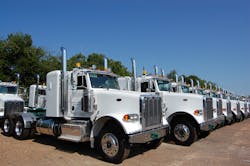Don’t let rate hike dampen new truck purchasing decision
With the Federal Reserve poised to raise interest rates for the first time in almost a decade, many in trucking are worried that financing for new truck purchases is about to get more expensive.
Yet Mike Spence, senior VP of fleet services for leasing firm Fleet Advantage, believes the efficiency potential of new truck models – particularly in terms of better fuel economy and lower maintenance costs – still far outweigh any near-term increase in the cost of borrowing money.
“A 1% rise in interest rates would increase a monthly [truck] payment by about $60 a month for an asset costing $115,000 on a five-year term, or about $3,600 over the term,” he told Fleet Owner.
However, by Fleet Advantage’s analysis, Spence said post-2010 model trucks can save fleets $800 in operating expenses versus older pre-2010 equipment – some $250 per month in fuel and $550 per month in maintenance, or some $9,600 per year.
“Every year, newer-model trucks are getting more fuel efficient and more reliable than older equipment,” he stressed. “On top of that, older trucks simply cost more to maintain.”
For those fleets leasing equipment, Spence offers two other suggestions to help offset potentially higher interest rates:
- Negotiate a lower equipment purchase price. If you were to negotiate a 1% price reduction in the equipment example above, Spence said, the lower lease payment would partially offset the higher interest rates by $20 per month or $1,200 over the term.
- Extend your lease term or take a larger residual position at the end of the term. Although this will lower the monthly payment, Spence said such moves will increase the interest amount paid over the term.
Yet he emphasized that the best approach for reducing equipment costs is to keep looking for ways to lower operational costs, which can far outweigh the impact of the asset cost or interest rate adjustments.
“By focusing on the total cost of ownership of the asset – including all variable and fixed expenses – you can achieve even greater savings,” Spence indicated.
In addition, emerging technologies and new safety features not only make newer equipment more efficient and cost-effective, but safer as well.
“Performing a comprehensive comparative cost analysis is a must in any acquisition decision, as it not only considers the original equipment cost, interest rates, and financing options but most importantly the asset operating costs over the operating term,” Spence explained. “This can make a solid case for the acquisition of new equipment even with an increase in interest rates.”
About the Author
Sean Kilcarr
Editor in Chief
Sean Kilcarr is a former longtime FleetOwner senior editor who wrote for the publication from 2000 to 2018. He served as editor-in-chief from 2017 to 2018.
